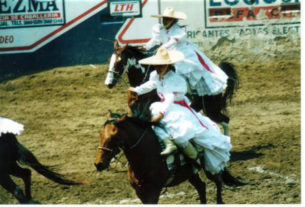Mexican Kitchen
A friend from western Mexico is on the phone, planning a trip to visit us down south in Oaxaca.
“From the map, it looks like there’s a freeway loop around Mexico City,” he says hopefully.
Yes, well. We explain to him that the map was evidently put together by someone with great futuristic vision, because the loop it indicates in no way resembles a freeway. It is a road that goes through several towns in the Estado de Mexico – State of Mexico – which nearly completely surrounds the capital. But the alternative is driving through Mexico City, which many out-of-towners are loath to do.
However, there is one very bright spot in all of this, which we hasten to mention. After several trips, many of them circling the city via the State of Mexico, we have discovered some fine culinary pit stops among its volcanic peaks and fertile valleys.
This area, like most of central Mexico, is known for the abundant natural resources that led to its early settlement.
The volcanic mountain chains that cross this high plateau, or altiplano, provide a variety of soil conditions, yielding an array of produce for sale in the area’s many markets. Different elevations create diverse climatic characteristics even a few miles apart. Mountain streams contain trout that are grilled fresh or served in a variety of tasty ways. Native wildlife such as duck and rabbit are prepared in adobos and pipianes, and turkey, another Mexican native, is most often served in mole.
Cultural centers since pre-Hispanic times, the urban areas, towns and villages that comprise what is now the State of Mexico have ancient gastronomic traditions that are evident in contemporary cooking. Herbs and vegetables such as nopales (cactus paddles), verdolagas (purslane), berros (watercress) and epazote (wormseed) have traditionally been used to lend a distinctive flavor to the local cooking, as have chiles and seeds, notably pumpkin and sesame.
The area’s most famous beverage is pulque, a mildly alcoholic fermentation of the juice ( agua miel) extracted from the maguey plant. Pulque fermented with ancho chiles and epazote is called chiloctli, and though it sounds like it would make a good marinade, it is a ritual drink at family occasions. Another local libation with anchos and epazote added is nanche, made from the fruit of the loquat tree infused in aguardiente, cane alcohol. Enjoyed throughout the country, but originating in the State of Mexico, the beverage called mosco (gnat) is a sweet liquor made with oranges and other fruit, depending on availability. Chumiate, another liquor, is made with a variety of herbs such as mint, lemon grass, chamomile and field anise. Town stores and markets sell these beverages as well as the ingredients to make them at home, which many people do.
The food of this state can be just as adventurous as its drinks, as we’ve learned through many a rest stop, planned destination, or wrong turn. Sometimes it’s best to just give up driving in circles for a while, and stop and see what’s cooking.
Coming from western Mexico toward the central region, most travelers opt for Highway 15, through Toluca, the Estado de Mexico state capital, choosing either to pass through or to stop and see the city. In our case, we just got lost there.
Tired of driving around, we spent the night and had some terrific tacos de carnitas in the huge Plaza de Los Mártires. This city, besides boasting museums specializing in everything from coins, stamps and science to history, anthropology and fine arts, is known for its pork, including the wonderful chorizo, spicy sausage that comes in either red, flecked with pieces of chile, or green, made with finely chopped herbs. Besides the ubiquitous porky products, we enjoyed the local sweets, especially the nightime hot chocolate at the cafes lining the portales that open onto the plaza.
Finally heading east on Highway 15 from Toluca, we decided on a rest stop at one of the cabañas (literally “cabins”, but actually small roadside restaurants) that line the highway between Toluca and Mexico City. Thinking of having a cold drink and a quesadilla, we stopped at a place called El Portasuelo and ended up having a huge, delicious meal. A mom and pop operation like most of the cabañas, the restaurant did indeed feature quesadillas, the fabulous central Mexican kind with either quesillo (string cheese) or requesón (somewhat like ricotta) and a choice of chorizo, roasted poblano chile strips, wild mushrooms, chicken, picadillo, squash blossoms and more.
One look at the menu, however, and we were way beyond quesadillas. The local fresh trout was offered in a variety of ways, including grilled, fried, al mojo de ajo (the classic Mexican preparation of fish with garlic) a la naranja (in orange sauce) a la mexicana (with chile and tomato salsa) a la diabla (deviled) and adobado (in a chile rub.)
My husband chose a trucha empapelada (trout en papilotte) and I went with another local specialty, rabbit. I ordered it in adobo and was not disappointed. Indeed, I look forward to returning to one of those cabañas on another trip and trying out one of the other rabbit dishes. Rabbit is not frequently encountered on menus, but the few times I’ve seen and ordered it in Mexico, it has been delicious. An hour and a half later, our planned half-hour rest stop was over. So much for plans.
We have also gotten lost in the opposite direction, coming from the south and trying to get to Toluca and points west. Proceeding north nicely on Highway 55, we saw a sign that said Toluca, stopped and foolishly asked the elderly man who shuffled out at the entrance to the road if this was really the way to Toluca. Yes, he assured us, it was. It turned out to be a way to Toluca – a nine hour way – if not the way – a three hour way. (It may have eventually led to Chicago, too, but couldn’t really be called the way there, either.) Many months later, we found a line in a guidebook warning us “Do not be tempted to take this route.” But these wrong turns can reveal something we wouldn’t want to miss anyway, and this one led to one of our favorite gastronomic pleasures, hongos silvestres – wild mushrooms.
Those not taking that route will never end up in Santiago Tianguistenco, a town noted for its variety of wild mushrooms, and well worth a stop for caldo de hongos, a regional mushroom soup. Also featured at the several small restaurants are tlacoyos, blue corn dough stuffed with a paste of arvejón or other beans, baked to order on the comal and topped with a choice of salsas and cheese. For the really daring, there are atepocates, frog embyos with tomatoes and chiles, cooked in corn leaves. We weren’t ready for this particular local specialty, but blue corn tlacoyos fresh off the comal are irresistible.
Coming through the State of Mexico from the north, along Highway 57, the Querétaro-Mexico route, other exotic regional dishes are found in Tepotzotlan, home of the National Museum of the Virreinato (colonial period.) Once the visitor has ogled over the treasures in this XVII century marvel of Churrigueresque (Mexican Ultra-Baroque) architecture, a stop at one of the many outdoor cafes across the street is in order. At Casa Mago, the fresh trout is often accompanied by the story of Elizabeth Taylor stopping there in 1963 – something local old timers have not forgotten. If the café fare seems too mild, venture closer to the market and order some escamole – ant eggs, considered a delicacy in Mexico – served with guacamole and salsa.
Not as exotic as ant eggs or frog embryos, but one of our favorite of all Mexican specialties, is found in the part of the state that lies east of the D.F. Barbacoa, appreciated all over the central area of the country, is nowhere more popular than in Texcoco, founded in the 12th century by Chichimecas and later inhabited by Alcohuans, commonly known as Texcocans after the great lake on whose shores they lived.
This historic city was the home of the great philosopher king and poet Nezahualcoyotl, whose likeness graces today’s $100 Mexican peso bill. Considering that the pre-Hispanic inhabitants of Mexico had no wool-bearing animals, the king and his contemporaries might be puzzled at the sight of barbacoa de borrego – sheep barbeque – establishments literally lining the highway through Texcoco.
This is deep pit barbeque, requiring a large hole in the ground lined with volcanic rock heated by a fire that must be kept burning for hours to get the rocks hot enough to hold the heat. Once the rocks are deemed hot enough, the butchered animal is wrapped in maguey leaves and lowered into the pit over a large pan that will catch the liquid to be served as consome, a traditional accompaniment to barbacoa.
This is not exactly fast food, and usually only served on weekends, when the road in front of the barbacoa restaurants is lined with cars. Happily, ours has been among them and a stop for barbacoa is a “must” when traveling through Texcoco. My husband has even done it at home, digging a hole in the field behind our house and sending me off to the market in search of the pencas de maguey with which to wrap the butchered sheep that he and a friend had purchased.
Not everyone can (or would want to) do an entire barbacoa de borrego, but the following recipes from the State of Mexico are easily prepared at home, for a taste of the truly delicious cuisine of the country’s most populous state.
- Trucha Empapelada: Trout en Papillote
- Caldo de Hongos Silvestres: Wild Mushroom Broth
- Huaraches: Cheese Stuffed Nopales
- Pechuga de Pato en Pipian Verde: Duck Breast in Pumpkin Seed Sauce


